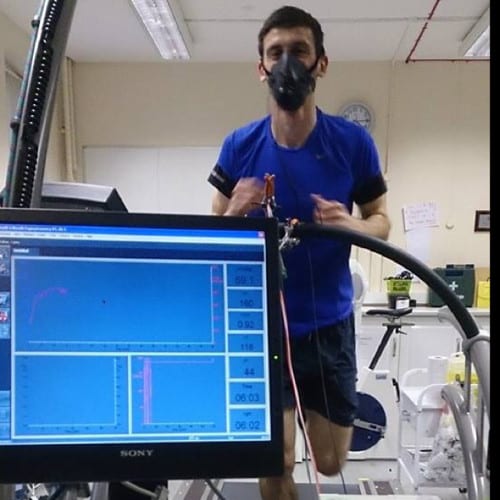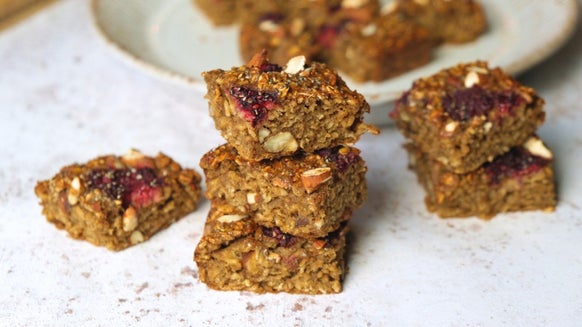Half Marathon Training Plan | A Beginner’s Guide

Written by Amy Golby
Prepare For A Half Marathon
There is nothing more rewarding feeling the crossing the finish line of an event you’ve trained and prepped for over the last months and the best thing about that feeling is anyone can get it. Running events are for everyone and there are so many to choose from now you’re sure to find a route, location and reason that work for you.
Half marathons are challenge but manageable and even most brand new runners can conquer the course with as little as three month training. Half marathons don’t require the hours and hours of running at the weekend a full marathon does and I mean who doesn’t love the feel of a shiny medal around their neck. If your worries about injury, there’s no need to half marathons are ideal for you – injury levels tend to be a lot lower then compared to longer distance races.
If you’ve already signed up for a half marathon or you’re contemplating it here is my beginners guide to running your first half –marathon.
This 12 week program is made up of a mixture of gym based exercises, runs (run/walks is required) and strength work to ensure your joints are protected effectively.

| Tues | Wed | Thurs | Fri | Sun | |
| WEEK 1 | Cross- trainer 20 mins | 2 mile – (non-stop run or Run/walk of 3:1) | Cross –trainer – 10 mins & strength program | 2 miles - (easy run or Run/walk of 3:1) | 3 mile run |
| WEEK 2 | Cross- trainer 20 mins | 2 mile – (non-stop run or Run/walk of 3:1) | Cross –trainer – 10 mins & strength program | 2 miles - (easy run or Run/walk of 3:1) | 4 mile run |
| WEEK 3 | Cross- trainer 25 mins | 2 mile – (easy run or Run/walk of 5:1) | Cross –trainer – 15 mins & strength program | 2 miles – non-stop run | 5 mile run |
| WEEK 4 | Cross- trainer 25 mins | 2 mile – Easy run | Cross –trainer – 15 mins & strength program | 3 miles (easy run or Run/walk of 5:1) | 3 mile run |
| WEEK 5 | Cross- trainer 25 mins | 2 miles run– (easy run or Run/walk of 5:1) | Cross –trainer – 15 mins & strength program | 3 miles (easy run or Run/walk of 5:1) | 6 mile run |
| WEEK 6 | Cross- trainer 35 mins | 3 mile – (non-stop run or Run/walk of 7:1) | Cross –trainer – 20 mins & strength program | 3 miles (easy run or Run/walk of 5:1) | 7 mile run |
| WEEK 7 | Cross- trainer 35 mins | 3 mile – (Easy run or Run/walk of 7:1) | Cross –trainer – 20 mins & strength program | 3 miles Non-stop run | 8 mile run |
| WEEK 8 | Cross- trainer 35 mins | 3 mile easy run | Cross –trainer – 20 mins & strength program | 3 miles (easy run or Run/walk of 7:1) | 5 mile run |
| WEEK 9 | Cross- trainer 40 mins | 3 mile – (non-stop run or Run/walk of 7:1) | Cross –trainer – 25 mins & strength program | 4 miles (easy run or Run/walk of 7:1) | 9 mile run |
| WEEK 10 | Cross- trainer 40 mins | 3 mile – (non-stop run or Run/walk of 7:1) | Cross –trainer – 25 mins & strength program | 4 miles (easy run or Run/walk of 7:1) | 10 mile run |
| WEEK 11 | Cross- trainer 40 mins | 3 mile easy run | Cross –trainer – 25 mins & strength program | 3 miles non-stop run | 11 mile run |
| WEEK 12 | 3 mile non-stop run | Cross –trainer – 25 mins | 2 mile easy | REST | RACE DAY |
Key Points
*Run/walk – the ratio beside this E.G 3:1 means 3 minutes of running and 1 minuet of walking (make sure to note that some ratio of run/walk change)
*Easy run – this pace should be moderate; you should be able to hold a conversation while running
*Non-stop run – This pace should be below race pace but higher than your moderate pace; it should be hard to talk while running
*Cross-trainer – you can swap this out for a different cardio vascular activity if you wish e.g rowing, cycling, swimming, sports, spinning ect –
*Strength training – stick to the below strength program making sure to increase the intensity slight when it becomes easier. –NOTE sets and reps change over the weeks.
| UPPER BODY & CORE | LOWER BODY | |
| WEEK 1 | REST |
3 sets of 12-15 reps- Body weight or light weight squats 3 sets of 12-15 reps - Body weight Lunges or light weight (each leg) 3 sets of 12 Reps- Romanian dead lift (light weight) 3 sets of 12-15 reps – Leg press (light weight) |
| WEEK 2 |
3 sets of 10 reps – press up (full body or on knees) 3 sets of 12 -15 reps - Bicep curls (light weight) 3 sets of 12-15 reps -Tricep dips (body weight on bench) 3 sets of 12-15 reps -chest press machines (light weight) 3 sets of 12-15 reps – seated row machine (light weight) CORE 3 sets 30 sec – plank (on feet or knees) 3 sets of 15-20 – crunches 3 sets of 20 – bicycle crunches (10 each side) 3 sets of 10 – leg raises (straight leg or bent knee) |
REST |
| WEEK 3 | REST |
3 sets of 12-15 reps- Body weight or light weight squats 3 sets of 12-15 reps - Body weight Lunges or light weight (each leg) 3 sets of 12 Reps- Romanian dead lift (light weight) 3 sets of 12-15 reps – Leg press (light weight) |
| WEEK 4 |
3 sets of 10 reps – press up (full body or on knees) 3 sets of 12 -15 reps - Bicep curls (light weight) 3 sets of 12-15 reps -Tricep dips (body weight on bench) 3 sets of 12-15 reps -chest press machines (light weight) 3 sets of 12-15 reps – seated row machine (light weight) CORE 3 sets 30 sec – plank (on feet or knees) 3 sets of 15-20 – crunches 3 sets of 20 – bicycle crunches (10 each side) 3 sets of 10 – leg raises (straight leg or bent knee) |
REST |
| WEEK 5 |
3 sets of 10 reps – press up (full body or on knees) 3 sets of 12 -15 reps - Bicep curls (light weight) 3 sets of 12-15 reps -Tricep dips (body weight on bench) 4 sets of 12-15 reps -chest press machines (light weight) 4 sets of 12-15 reps – seated row machine (light weight) CORE 3 sets 30 sec – plank (on feet or knees) 3 sets of 15-20 – crunches 3 sets of 20 – bicycle crunches (10 each side) 3 sets of 10 – leg raises (straight leg or bent knee) |
3 sets of 12-15 reps- Body weight or light weight squats 3 sets of 12-15 reps - Body weight Lunges or light weight (each leg) 3 sets of 12 Reps- Romanian dead lift (light weight) 3 sets of 12-15 reps – Leg press (light weight) |
| WEEK 6 | REST |
3 sets of 12 reps- squats with dumbbells 3 sets of 12 reps - Lunges with dumbbells (each leg) 3 sets of 12 Reps- Romanian dead lift (light weight) 3 sets of 12 reps – Leg press (light weight) 3 sets of 10 squat jumps
|
| WEEK 7 |
3 sets of 10 reps – press up (full body or on knees) 3 sets of 12 -15 reps - Bicep curls (light weight) 3 sets of 12-15 reps -Tricep dips (body weight on bench) 3 sets of 12-15 reps -chest press machines (light weight) 3 sets of 12-15 reps – seated row machine (light weight) CORE 3 sets 30 sec – plank (on feet or knees) 3 sets of 15-20 – crunches 3 sets of 20 – bicycle crunches (10 each side) 3 sets of 15 – leg raises (straight leg or bent knee) 3 sets of 20 – side crunches (10 each side) |
3 sets of 12-15 reps- Body weight or light weight squats 3 sets of 12-15 reps - Body weight Lunges or light weight (each leg) 3 sets of 12 Reps- Romanian dead lift (light weight) 3 sets of 12-15 reps – Leg press (light weight) |
| WEEK 8 |
3 sets of 10 reps – press up (full body or on knees) 3 sets of 12 -15 reps - Bicep curls (light weight) 3 sets of 12-15 reps -Tricep dips (body weight on bench) 3 sets of 12-15 reps -chest press machines (light weight) 3 sets of 12-15 reps – seated row machine (light weight) CORE 3 sets 30 sec – plank (on feet or knees) 3 sets of 15-20 – crunches 3 sets of 20 – bicycle crunches (10 each side) 3 sets of 15 – leg raises (straight leg or bent knee) 3 sets of 20 – side crunches (10 each side) |
REST |
| WEEK 9 |
3 sets of 10 reps – press up (full body or on knees) 3 sets of 12 -15 reps - Bicep curls (light weight) 3 sets of 12-15 reps -Tricep dips (body weight on bench) 4 sets of 12-15 reps -chest press machines (light weight) 4 sets of 12-15 reps – seated row machine (light weight) CORE 4 sets 30 sec – plank (on feet or knees) 3 sets of 15-20 – crunches 3 sets of 20 – bicycle crunches (10 each side) 3 sets of 15 – leg raises (straight leg or bent knee) 3 sets of 20 – side crunches (10 each side) |
3 sets of 12 reps- squats with dumbbells 3 sets of 12 reps – Sumo squats 3 sets of 12 Reps- Romanian dead lift (light weight) 3 sets of 12 reps – Bulgarian split squats (raised back leg lunge) (light weight) 3 sets of 10 squat jumps
|
| WEEK 10 |
3 sets of 10 reps – press up (full body or on knees) 3 sets of 12 -15 reps - Bicep curls (light weight) 3 sets of 12-15 reps -Tricep dips (body weight on bench) 4 sets of 12-15 reps -chest press machines (light weight) 4 sets of 12-15 reps – seated row machine (light weight) CORE 4 sets 30 sec – plank (on feet or knees) 3 sets of 15-20 – crunches 3 sets of 20 – bicycle crunches (10 each side) 4 sets of 15 – leg raises (straight leg or bent knee) 3 sets of 20 – side crunches (10 each side) |
3 sets of 12 reps- squats with dumbbells 3 sets of 12 reps – Sumo squats 3 sets of 12 Reps- Romanian dead lift (light weight) 3 sets of 12 reps – Bulgarian split squats (raised back leg lunge) (light weight) 3 sets of 10 squat jumps |
| WEEK 11 |
3 sets of 10 reps – press up (full body or on knees) 3 sets of 12 -15 reps - Bicep curls (light weight) 3 sets of 12-15 reps -Tricep dips (body weight on bench) 3 sets of 12-15 reps -chest press machines (light weight) 3 sets of 12-15 reps – seated row machine (light weight) CORE 3 sets 30 sec – plank (on feet or knees) 3 sets of 15-20 – crunches 3 sets of 20 – bicycle crunches (10 each side) 3 sets of 15 – leg raises (straight leg or bent knee) 3 sets of 20 – side crunches (10 each side) |
REST |
| WEEK 12 | REST | REST |
Kick start your training plan and gain optimal performance using our Endurance Range.

Casey Walker is an experienced sports nutrition new product development technologist. He holds a Bachelor of Science in Sports and Exercise Science and a Master of Science in Sports Sciences and Physiology.
Casey’s scientific research area of expertise lies in the effects of dietary nitrates on sprint performance and exercise-induced muscle damage. He has also worked as a sports scientist for a medal-winning Paralympic track cyclist, with a goal of qualifying for the Rio 2016 Paralympics.
Find out more about Casey’s experience here.
In his spare time, Casey is a keen middle-distance runner with an interest in triathlon. He’s always looking out for the latest blends and supplements to improve his half-marathon time and recovery.







